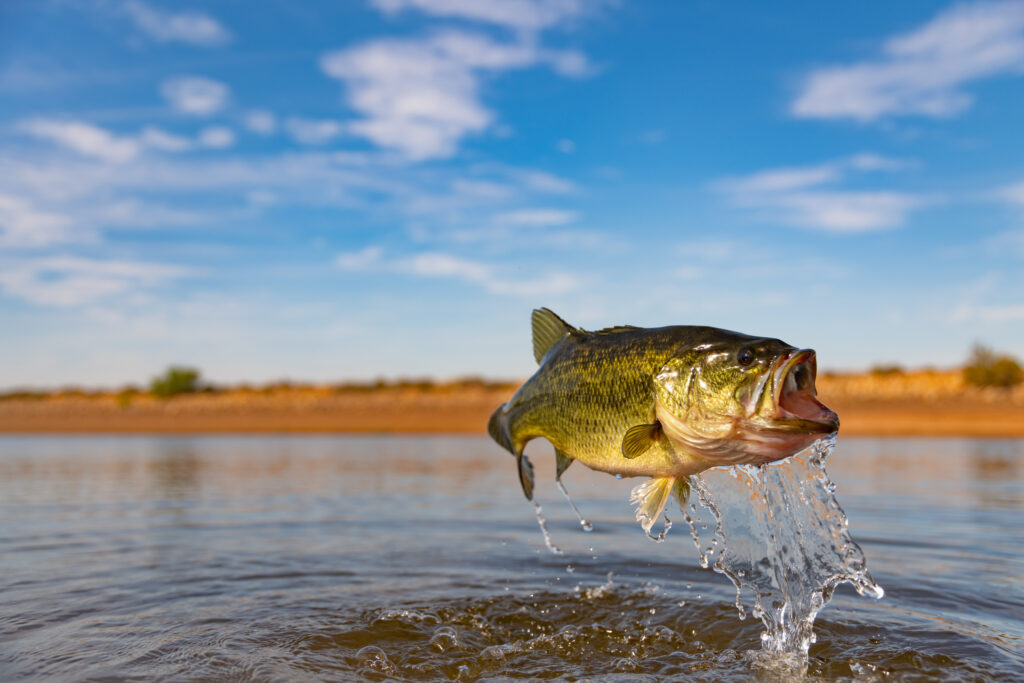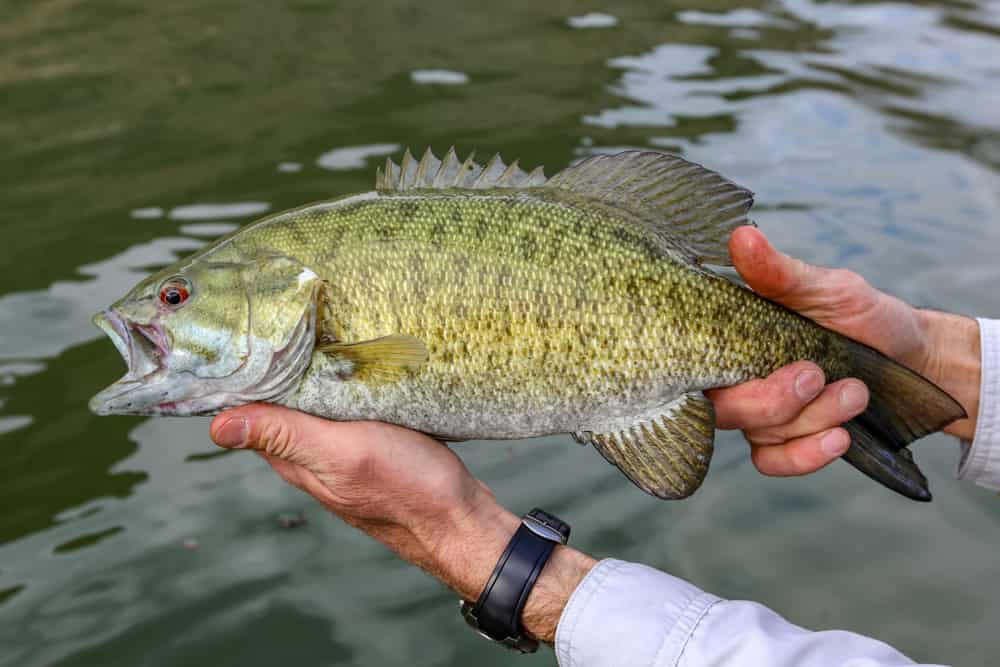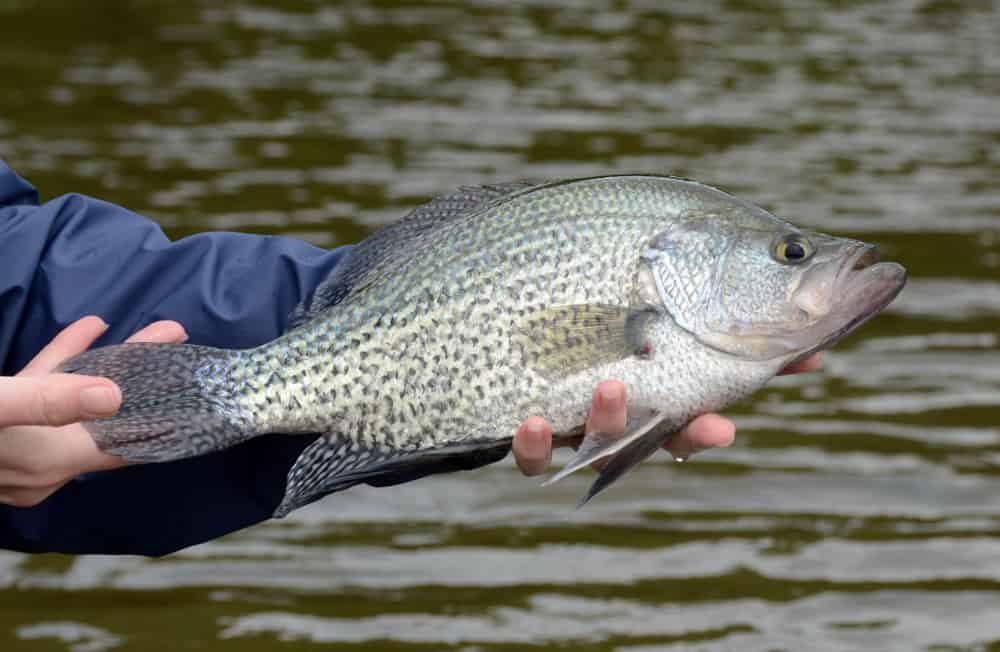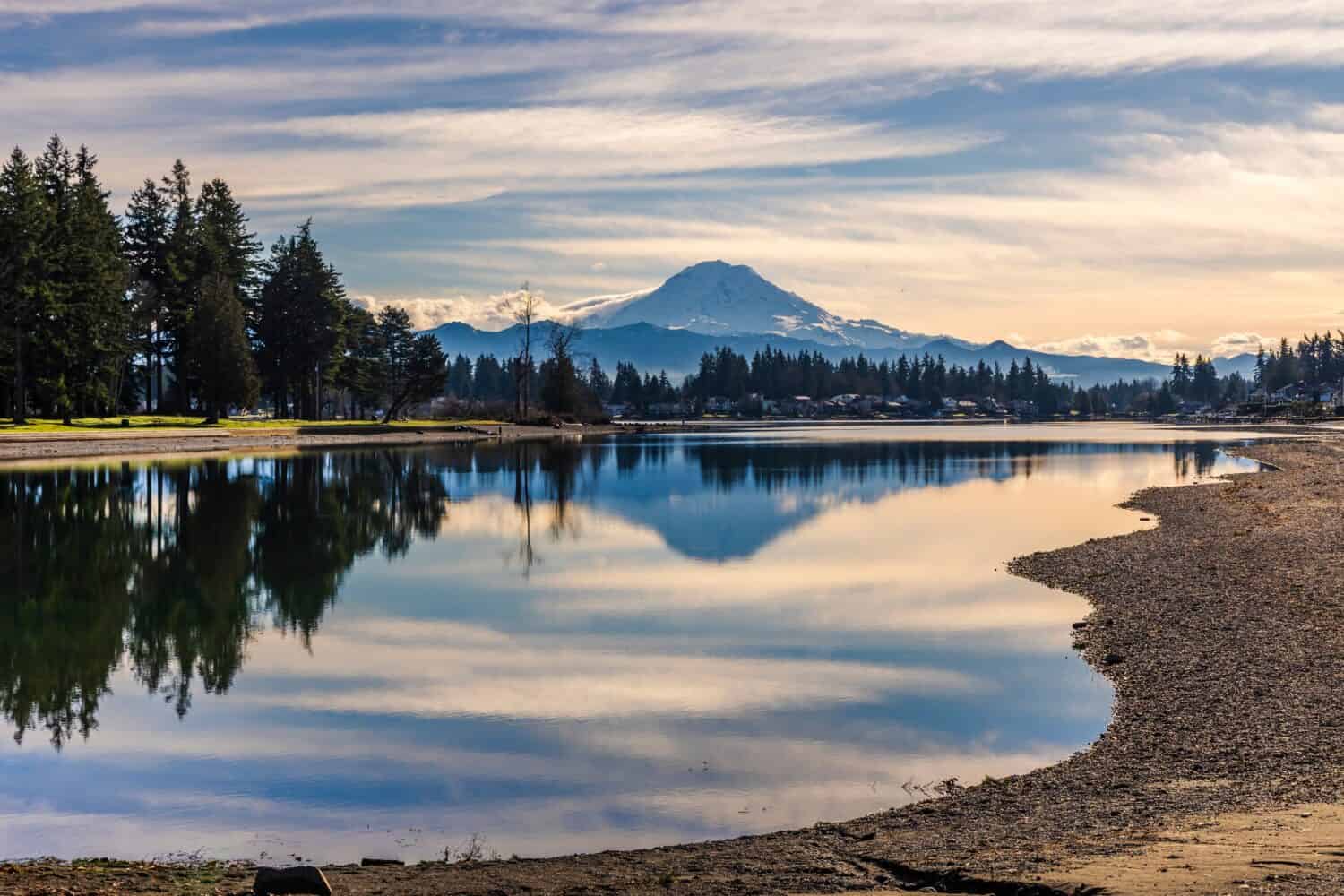Lake Tapps is a gorgeous lake in Pierce County, Washington that sits beneath Mt. Rainier. It’s a popular summer spot, and many enjoy boating across its pristine waters. With about 135 acres of undisturbed woodlands, Lake Tapps offers 10,000 feet of waterfront with expansive, sandy spots for swimming. Learn all about Lake Tapps, including fishing, size, depth, and more.
Location
Located in Pierce County, Washington, Lake Tapps is between State Route 410 and 164. Just east of Puget Sound, many surrounding cities like Auburn, Bonney Lake, Buckley, and Sumner take advantage of all the outdoor recreational opportunities at the lake.
How Big Is Lake Tapps?
Lake Tapps is 2433.10 acres in size with 45 miles of beautiful shoreline. Per the Water Rights and agreements between the lake’s owners (Cascade Water Alliance) and the Lake Tapps Community, the Puyallup Tribe of Indians, and the Muckleshoot Indian Tribe, Cascade maintains higher water levels for summer recreation. Between April 15th through September 30th, Cascade may keep the lake between elevations of 541.5 and 543 feet.
In the fall, the lake level drops to elevations of 538 and 539 feet. This is enough to safeguard the dikes from deterioration and minimize complications in refilling Lake Tapps during a potential water shortage.
At its lowest point, the lake is about 90 feet deep, and it has a 46,700 acre-feet water storage capacity.
The History of the Lake

One amazing feature about Lake Tapps is that it has 45 miles of beautiful shoreline.
©Nick Alvarez/Shutterstock.com
Lake Tapps is a man-made reservoir that was constructed in 1911. Because the area was rapidly developing, the Puget Sound Power and Light Company launched its White River Project. The company planned to use the glacier waters running down Mount Rainier for hydroelectric power.
They set their sights on an area of four small lakes, most likely formed from glaciers, which were Church Lake, Crawford Lake, Lake Kirtley, and Lake Tapp. By creating about two and a half miles of dikes that diverted water from the White River, the new current flowed into the eastern part of the area. Puget Sound Power and Light raised the water level over 35 feet, and the four lakes merged into one large reservoir known as Lake Tapps.
Puget Sound Power and Light stopped power production in 2004 and then sold the reservoir to the Cascade Water Alliance in 2009. Even though it no longer provides hydroelectric power, Lake Tapps still provides drinking water to more than 350,000 residents and 20,000 businesses in the area. Not to mention, it’s an extremely popular spot for water sports and outdoor recreation. Eventually, Cascade plans to utilize Lake Tapps to supply water to customers of its members.
Fishing
As a favored fishing location, Lake Tapps is a place where you can catch largemouth and smallmouth bass, tiger muskies, black crappie, and yellow perch. However, if you hook a tiger muskie less than 50 inches long, it must be released.
Lake Tapps North Park, on the northeast shore of Lake Tapps, features a convenient boat ramp, bathrooms, and bank access for anglers. You may also access the lake from Allan Yorke Park, which provides a launch and docks along the western shore.
Largemouth Bass

On average, largemouth bass are 12-15 inches long and weigh 12 pounds or more.
©Ryno Botha/Shutterstock.com
Though largemouth bass are a member of the sunfish family, they have a less “flattened” shape than most sunfishes. They also grow longer in length. Coloring ranges from forest green to olive, and this fish features bold, dark bands along the middle of the body. Also, as you can see from their name, largemouth bass have impressive mouths with the upper lip that extends past the eye. On average, largemouth bass are 12-15 inches long and weigh 12 pounds or more.
Smallmouth Bass

Typically, smallmouth bass will grow to be 12-16 inches and weigh three to six pounds.
©CSNafzger/Shutterstock.com
With its spiny and soft-rayed parts of the dorsal fin, you can see why smallmouth bass are a part of the sunfish family. As its name suggests, smallmouth bass have much smaller mouths than largemouth bass. The maxillary bone, which forms its top jaw, doesn’t go past the center of its eye. Smallmouth bass are marked with dots of color which vary depending on the water environment. They range from shades of green to golden and have dark vertical lines along the body. Typically, smallmouth bass will grow to be 12-16 inches and weigh three to six pounds.
Tiger Muskie

Adult tiger muskies grow to 34-48 inches long and weigh over 30 pounds.
©M Huston/Shutterstock.com
With a long, tube-shaped body and a lobe-shaped dorsal, the tiger muskie looks very similar to a northern pike. Young tiger muskies have dark spots or stripes across light scales, whereas a northern pike has light spots along its dark body. Fishermen should identify the differences between the two, as tiger muskies are game fish, but you cannot catch northern pike in Lake Tapps. Adult tiger muskies grow to 34-48 inches long and weigh over 30 pounds.
Black Crappie

Usually around seven to nine inches in length, black crappie may grow up to five pounds in weight.
©M Huston/Shutterstock.com
Black crappie have large rounded dorsal and anal fins. They have compressed bodies, almost like a pancake. This type of fish is very popular for fishing as they are easy to catch and make for excellent pan fish. You may identify them by their seven to eight dorsal spines and dark spots along their sides. Usually around seven to nine inches in length, they may grow up to five pounds in weight.
Yellow Perch

On average, they grow seven to 10 inches long and weigh four to 10 ounces.
©RLS Photo/Shutterstock.com
As a very popular type of pan fish, yellow perch not only taste delicious but are easy to catch. These fish are frequently spotted for their golden-yellow coloring, which is how they got their name! Along their sides, yellow perch have six to eight triangular stripes that range from olive to dark green in color. On average, they grow seven to 10 inches long and weigh four to 10 ounces.
Outdoor Recreational Activities
Boating
From jet skis to pontoons, residents savor an afternoon out on the waters of Lake Tapps. However, to launch boats from North Lake Tapps Park, you must reserve a spot 30 days in advance. You may also rent jet skis or paddleboards if you would like. So whether you are fishing, water tubing, or kayaking, Lake Tapps is a peaceful place to boat.
Swimming
As mentioned before, Lake Tapps has 10,000 feet of waterfront and many established, sandy spots for swimming. Other amenities of North Lake Tapps Park include picnic tables and charcoal grills for picnicking, coal dumps, and restrooms.
Hiking

There are several beautiful trails around Lake Tapps which also offer views of Mt. Rainier.
©kwan tse/Shutterstock.com
Several frequented trails begin in North Lake Tapps Park, which hikers take advantage of. The peninsula walking path leads right to a magnificent Mt. Rainier viewpoint.
Golf
Situated on a strip of land that is virtually an island, the Tapps Island Golf Course is surrounded by the peaceful waters of Lake Tapps. With a clear view of Mt. Rainier, this golf course is rated the best 9-hole course in Washington.
Learn Even More About Lake Tapps
Even though it is no longer producing the power for which it was once created, Lake Tapps is certainly a hot spot for residents and travelers alike. If you would truly love to learn more about Lake Tapps, plan a visit this summer. You must experience this gorgeous lake firsthand to appreciate the magnificence of Lake Tapps fully.
The photo featured at the top of this post is © kwan tse/Shutterstock.com
Thank you for reading! Have some feedback for us? Contact the AZ Animals editorial team.






